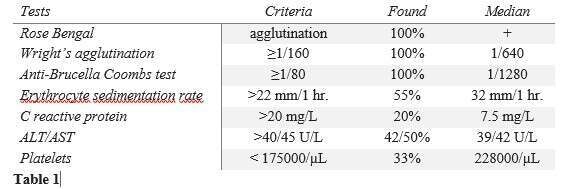
Evaluation of Diagnostic Tests in Pediatric Brucellosis
2Pediatric Infectious Diseases, Hospital Universitario La Paz, Spain
3Pediatric Reumathology, Hospital Universitario La Paz, Spain
4Pediatrics, Hospital Universitario Príncipe de Asturias, Spain
Introduction and Objectives: Brucellosis is a worldwide zoonosis which is currently in clear regression in Europe. In Spain, the incidence has been decreasing since 1990, although some human cases persist. The historical importance of this disease and the current lack of experience on its management, make us present this retrospective study.
The objective of our study is to assess the clinical validation of diagnostic tests performed in pediatric patients with brucellosis.
Methods: Retrospective study of 13 pediatric patients diagnosed from 1989 to 2018 (30 years), in two hospitals of Madrid province. The cases have been identified from the registries of Microbiology Services, hospital admissions and outpatient clinics.
Results: Cases were diagnosed from 1992 to 2003. All patients except of one, recognized consumption of not pasteurized milk products. Twelve out of thirteen patients presented arthralgias and / or arthritis; the most frequent locations were hip and sacroiliac joints. The median duration was 20 days for joint symptoms and 18 days for fever (median maximum temperature 38.7ºC).
The diagnosis was initially carried out wtih Rose Bengal test in all patients (100% positive). Table 1 shows results of main diagnostic tests.

Blood culture and bone scintigraphy weren’t carried out in all patients. Blood culture was positive in 50% and bone scintigraphy showed pathological findings in 60% of tested patients. Rifampicin combined with cotrimoxazole or doxycicline were the adopted treatment in most patients. One patient fell on a relapse after the initial treatment.
Conclusions: The number of patients diagnosed from brucellosis was small. We have not diagnosed any case of pediatric brucellosis in the last 15 years. Serological tests were positive in all cases. Erythrocyte sedimentation rate and C reactive protein were near normal in most patients. Blood cultures and bone scintigraphy were useful diagnostic tools in half of the patients.
Powered by Eventact EMS